Themed collection Editor’s Collection: Mechanochemistry

Reactive milling with metals for environmentally benign sustainable production
Two decades of reactive milling for environmentally benign sustainable production with metals.
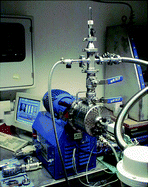
CrystEngComm, 2011,13, 3108-3121
https://doi.org/10.1039/C1CE05085K
Mechanochemistry: the varied applications of mechanical bond-breaking
Mechanical impact breaks infinitely covalent crystals providing surface plasma with exciting applications. Polymer technology profits from bond breaking with radical formation. Crashed (semi)metals start improved syntheses as do weak-bond molecules including explosives. Strong bonds in small molecules break by shear under Bridgman's anvil and at lubrication. Single bond breaking and nano-dissection are emerging.
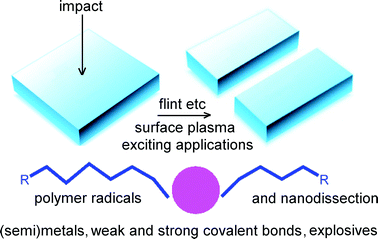
CrystEngComm, 2009,11, 388-403
https://doi.org/10.1039/B810822F
Mechanochemical synthesis of brexpiprazole cocrystals to improve its pharmaceutical attributes
In the present study, cocrystallization of a new piprazole analogue drug, brexpiprazole (BREX), with coformers such as succinic acid and catechol was carried out using ball milling to address the poor solubility and dissolution rate of the molecule.
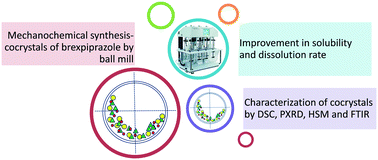
CrystEngComm, 2019,21, 800-806
https://doi.org/10.1039/C8CE01689E
Cocrystal formation by ionic liquid-assisted grinding: case study with cocrystals of caffeine
Liquid assisted grinding using imidazolium-based ionic liquids (IL-AG) was found to be effective in isolation of cocrystals and cocrystal polymorphs.
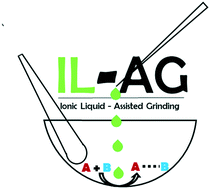
CrystEngComm, 2018,20, 3817-3821
https://doi.org/10.1039/C8CE00859K
Reversible mechanochromic and thermochromic luminescence switching via hydrogen-bond-directed assemblies in a zinc coordination complex
A zinc coordination complex with terpyridyl derivative as ligand exhibits mechanochromic and thermochromic luminescence behaviors with reversible color changes visible to the naked eye from pink to blue-purple upon mechanical grinding and from pink to blue upon heating.
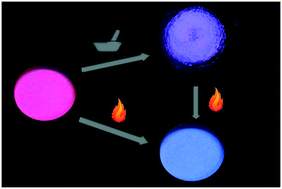
CrystEngComm, 2017,19, 6259-6262
https://doi.org/10.1039/C7CE01511A
Inadvertent liquid assisted grinding: a key to “dry” organic mechano-co-crystallisation?
The paper provides a prime example where liquid is required for a reaction, but simultaneously inhibits it. The results offer insights into possible regional, seasonal, polymer additive and temperature effects on mechanochemical synthesis.
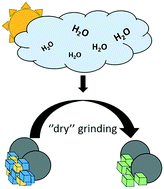
CrystEngComm, 2017,19, 2830-2835
https://doi.org/10.1039/C7CE00517B
Mechanical path to a photogenerated structure: ball milling-induced phase transition of a gold(I) complex
Ball milling of blue-emitting crystal 1B of gold(I) isocyanide complex 1 induces a phase transition to yellow-emitting powder 1YG, which has the same solid structure as the previously reported 1Y obtained upon photoirradiation of 1B.
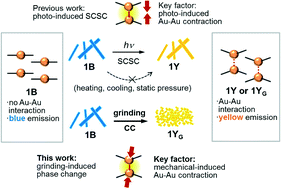
CrystEngComm, 2016,18, 7217-7220
https://doi.org/10.1039/C5CE02565F
Halogen bonding of N-bromosuccinimide by grinding
Two halogen bonded cocrystals of N-bromosuccinimide and 4,4′-bipyridine, with stoichiometric ratios 1 : 1 and 2 : 1, have been synthesized and characterized. We present the first mechanochemical cocrystallization of N-bromosuccinimide.
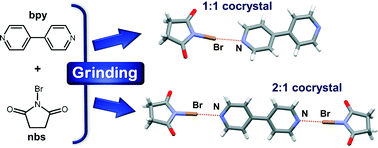
CrystEngComm, 2016,18, 3343-3346
https://doi.org/10.1039/C6CE00638H
Exploiting polymorphism in second sphere coordination: thermal transformation, NLO properties and selective mechanochemical synthesis
Polymorphism has been explored in a second sphere adduct using a racemic ligand that also shows racemic polymorphic behavior. The polar nature of the second sphere adduct allowed us to study NLO phenomena.
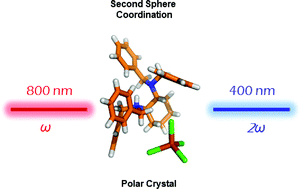
CrystEngComm, 2016,18, 2408-2412
https://doi.org/10.1039/C6CE00366D
Fast and efficient synthesis of a host guest system: a mechanochemical approach
In situ investigation and elucidation of the formation of a POM@MOF host guest system obtained by mechanosynthesis.

CrystEngComm, 2016,18, 1096-1100
https://doi.org/10.1039/C5CE01868D
Structure-dependent mechanochromism of two Ag(I) imidazolate chains
A Ag(I)-imidazolate coordination polymer showed unique luminescence mechanochromism due to the Ag⋯Ag and C–H⋯π interactions.

CrystEngComm, 2016,18, 218-221
https://doi.org/10.1039/C5CE01852H
Nanoscale 2CL-20·HMX high explosive cocrystal synthesized by bead milling
Nanoscale cocrystal of CL-20 and HMX with a rounded morphology was prepared by bead milling an aqueous suspension of the coformers.

CrystEngComm, 2015,17, 4080-4083
https://doi.org/10.1039/C5CE00489F
Phase transformation of mesoporous calcium carbonate by mechanical stirring
Mechanically stirring the precursor colloidal dispersion can control the polymorphs of mesoporous calcium carbonate.
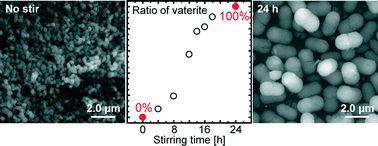
CrystEngComm, 2015,17, 1773-1777
https://doi.org/10.1039/C4CE02460E
Attrition-induced spontaneous chiral amplification of the γ polymorphic modification of glycine
Glycine is the simplest achiral amino acid that undergoes spontaneous mirror symmetry and controlled deracemization in its γ-polymorphic modification.
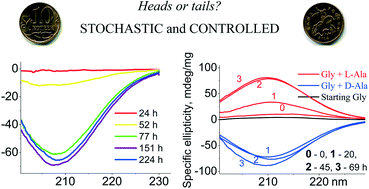
CrystEngComm, 2015,17, 1513-1517
https://doi.org/10.1039/C4CE02434F
Synthesis of an extended halogen-bonded metal–organic structure in a one-pot mechanochemical reaction that combines covalent bonding, coordination chemistry and supramolecular synthesis
We describe a four-component one-pot mechanochemical reaction which combines the formation of covalent bonds, coordination bonds and halogen bonds to obtain an extended structure based on halogen-bonded metal–organic units.
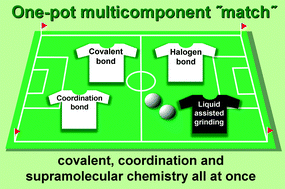
CrystEngComm, 2014,16, 10169-10172
https://doi.org/10.1039/C4CE01815J
A carbamazepine-indomethacin (1 : 1) cocrystal produced by milling
An X-ray amorphous mixture of carbamazepine and indomethacin transforms upon annealing to produce a novel 1 : 1 cocrystal.
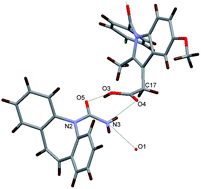
CrystEngComm, 2011,13, 6327-6328
https://doi.org/10.1039/C1CE05650F
A rational approach to screen for hydrated forms of the pharmaceutical derivative magnesium naproxen using liquid-assisted grinding
Systematic variation of water activity in the grinding liquid enables a rational strategy to mechanochemically screen for hydrated forms of magnesium-based pharmaceutical derivatives formed in situ from MgO and naproxen.

CrystEngComm, 2011,13, 3125-3129
https://doi.org/10.1039/C0CE00894J
Supramolecular metathesis : co-former exchange in co-crystals of pyrazine with (R,R)-, (S,S)-, (R,S)- and (S,S/R,R)-tartaric acid
Co-crystals of dextro-(R,R), levo-(S,S), meso-(R,S) and racemic (R,R–S,S)-tartaric acid with pyrazine were obtained by manual kneading and slurry experiments; upon their reaction with the various tartaric acid forms co-former exchange takes place, according to the sequence of stability [(R,S)-ta]2·py > (S,S/R,R)-ta·py > (R,R)-ta·py or (S,S)-ta·py.
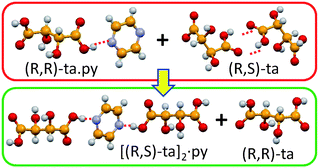
CrystEngComm, 2011,13, 3122-3124
https://doi.org/10.1039/C0CE00576B
Following the products of mechanochemical synthesis step by step
We describe a model study of “solid + solid” reaction with control over number, energy, duration, and frequency of individual mechanical pulses.

CrystEngComm, 2011,13, 2213-2216
https://doi.org/10.1039/C0CE00869A
Study of the mechanochemical formation and resulting properties of an archetypal MOF: Cu3(BTC)2 (BTC = 1,3,5-benzenetricarboxylate )
A study of the MOF formation by grinding together solid reactants in a ball mill reveals interesting aspects of morphology and reactivity; the product could also be activated to exhibit appreciable surface areas (>1300 m2g−1) although washing with solvent was required.
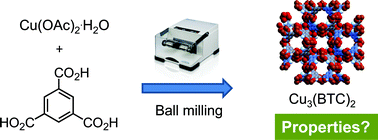
CrystEngComm, 2010,12, 4063-4065
https://doi.org/10.1039/C0CE00486C
New solid forms of artemisinin obtained through cocrystallisation
Cocrystals of artemisinin, an artificial antimalarial drug lacking sites for forming conventional supramolecular synthons, have been obtained by mechanochemical screening and the results analysed using molecular descriptors derived from the CSD.

CrystEngComm, 2010,12, 4038-4041
https://doi.org/10.1039/C0CE00428F
Solid state crystal-to-crystal transformation from a monomeric structure to 1-D coordination polymers on anion exchange,
Yellow crystals of monomeric structure [Zn(bpdh)2(H2O)4](NO3)2·2bpdh (1) convert on heating at ca. 160 °C under grinding and mixing with KSCN or NaN3 to white and orange 1D coordination polymers, [Zn(µ-bpdh)2(NCS)2]n (2) and [Zn(µ-bpdh)2(N3)2]n (3), respectively.

CrystEngComm, 2009,11, 2585-2587
https://doi.org/10.1039/B908362F
Drug-containing coordination and hydrogen bonding networks obtained mechanochemically
Coordination and hydrogen bonding networks of the antibiotic 4-aminosalicylic acid and of the nootropic drug piracetam with silver and nickel cations have been prepared mechanochemically; in the case of silver, solid-state and solution reactions afforded different crystalline materials.
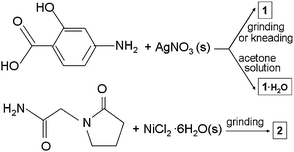
CrystEngComm, 2009,11, 2618-2621
https://doi.org/10.1039/B913433F
Mechanochemical conversion of a metal oxide into coordination polymers and porous frameworks using liquid-assisted grinding (LAG)
Mechanochemical method of liquid-assisted grinding enables rapid and clean conversion of an inexpensive metal oxide into diverse coordination polymers and porous frameworks for preparative and screening purposes.
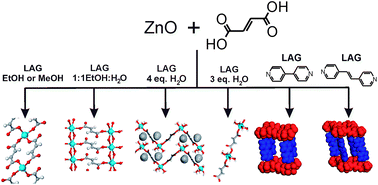
CrystEngComm, 2009,11, 743-745
https://doi.org/10.1039/B822934C
The utility of a ternary phase diagram in the discovery of new co-crystal forms
The construction of the ternary phase diagram urea–glutaric acid–water has led to the discovery of a new co-crystal form.
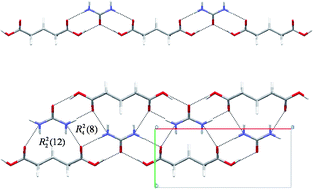
CrystEngComm, 2009,11, 412-414
https://doi.org/10.1039/B818268J
Nonlinear effects in proline -catalysed aldol reactions under solvent-free conditions based on the ternary phase behaviour of scalemic proline
Under solvent-free conditions in a ball mill a significant nonlinear relationship between the enantiomeric excess of the catalyst (proline) and that of the product was observed, when solely solid substrates were used.

CrystEngComm, 2009,11, 404-407
https://doi.org/10.1039/B821415H
Nicotinamide fumaric acid supramolecular cocrystals: diversity of stoichiometry
Synthesis of nicotinamide and fumaric acid supramolecular cocrystals with 1 : 1 and 2 : 1 amide to acid stoichiometries results in the formation of an amide–acid heterosynthon (1 : 1 stoichiometry) and an amide–amide homosynthon (2 : 1 stoichiometry) and different conformations of the fumaric acid moieties.
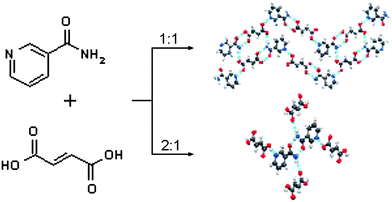
CrystEngComm, 2009,11, 415-417
https://doi.org/10.1039/B818667G
Simple and quantitative mechanochemical preparation of the first zinc and copper complexes of the neuroleptic drug gabapentin
The solid-state preparation and structural characterization of the first two coordination complexes of the neuroleptic drug gabapentin.

CrystEngComm, 2008,10, 469-471
https://doi.org/10.1039/B719451J
Solvent -free synthesis of a microporous metal–organic framework
Solvent-free grinding is demonstrated as an effective way to produce a porous 3-dimensional metal–organic framework.
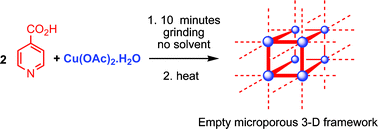
CrystEngComm, 2006,8, 211-214
https://doi.org/10.1039/B513750K
Unprecedented mechanochemical preparation of 18Crown[6] and 15Crown[5] adducts of ammonium hydrogen sulfate by grinding or kneading
Novel crown ether complexes, 18Crown[6]·[NH4][HSO4]·2H2O and (15Crown[5])3·[NH4]2[H3O][HSO4]3·H2O have been prepared, respectively, by grinding and kneading of solid 18Crown[6] and of liquid 15Crown[5] with solid [NH4][HSO4].
![Graphical abstract: Unprecedented mechanochemical preparation of 18Crown[6] and 15Crown[5] adducts of ammonium hydrogen sulfate by grinding or kneading](/en/Image/Get?imageInfo.ImageType=GA&imageInfo.ImageIdentifier.ManuscriptID=B504459F&imageInfo.ImageIdentifier.Year=2005)
CrystEngComm, 2005,7, 276-278
https://doi.org/10.1039/B504459F
Mechanochemical and solution preparation of the coordination polymers Ag[N(CH2CH2)3N]2[CH3COO]·5H2O and Zn[N(CH2CH2)3N]Cl2
Two solid-state coordination reactions for the polymers g[N(CH2CH2)3N]2[CH3COO]·5H2O and Zn[N(CH2CH2)3N] and their solution counterparts, as well as two discussions of X-ray results are presented.
![Graphical abstract: Mechanochemical and solution preparation of the coordination polymers Ag[N(CH2CH2)3N]2[CH3COO]·5H2O and Zn[N(CH2CH2)3N]Cl2](/en/Image/Get?imageInfo.ImageType=GA&imageInfo.ImageIdentifier.ManuscriptID=B406375A&imageInfo.ImageIdentifier.Year=2004)
CrystEngComm, 2004,6, 459-462
https://doi.org/10.1039/B406375A
The mechanochemical conversion of potassium coordination polymer nanostructures to interpenetrated sodium coordination polymers with halogen bond, metal–carbon and metal–metal interactions
Two new Na and K coordination polymers with halogen bond, metallophilic and hydrogen bonding interactions were synthesized. These two compounds were synthesized sonochemically and solid-state conversions of them to each other were investigated.
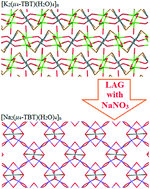
CrystEngComm, 2020,22, 888-894
https://doi.org/10.1039/C9CE01861A
Stoichiometry mechanosynthesis and interconversion of metal salts containing [CuCl3(H2O)]− and [Cu2Cl8]4−
The mechanochemical interconversion of two salts was achieved by the addition of an appropriate amount of one of the corresponding components (HL or CuCl2·2H2O), and the progress of dynamic interconversion was revealed by PXRD, fluorescence and Raman spectroscopy.
![Graphical abstract: Stoichiometry mechanosynthesis and interconversion of metal salts containing [CuCl3(H2O)]− and [Cu2Cl8]4−](/en/Image/Get?imageInfo.ImageType=GA&imageInfo.ImageIdentifier.ManuscriptID=C9CE00911F&imageInfo.ImageIdentifier.Year=2019)
CrystEngComm, 2019,21, 7017-7024
https://doi.org/10.1039/C9CE00911F
Affinity prediction computations and mechanosynthesis of carbamazepine based cocrystals
A combination of the excess enthalpy with the fusion entropy of the pure coformer is suggested to be of interest for coformers screening in order to form a multicomponent system with a given API (cocrystal/co-amorphous).
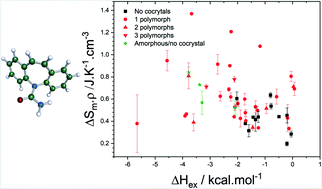
CrystEngComm, 2019,21, 6991-7001
https://doi.org/10.1039/C9CE01160A
Ball size or ball mass – what matters in organic mechanochemical synthesis?
The effects of milling ball mass, size and material are isolated for a model mechanochemical co-crystallisation.
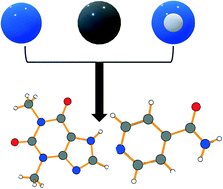
CrystEngComm, 2019,21, 2174-2179
https://doi.org/10.1039/C8CE02109K
On the kinetics of solvate formation through mechanochemistry
We demonstrate that solvates obtained through mechanochemistry are the thermodynamic products, and that the kinetics of solvate formation are related to the easiness of breaking the reactant crystals.
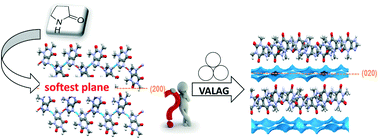
CrystEngComm, 2019,21, 2097-2104
https://doi.org/10.1039/C8CE00871J
Dynamic behaviour in nonporous hybrid metal–organic materials via mechanochemical and gas–solid reactions
Nonporous hybrid metal organic materials have been studied in the solid-state by mechanochemical reactions, chemisorption and release of HCl by heating. The dynamic behavior of the hybrid materials allows the breaking and formation of chemical bonds.

CrystEngComm, 2018,20, 6721-6726
https://doi.org/10.1039/C8CE01287C
Comparative studies on conventional and solvent-free synthesis toward hydrazones: application of PXRD and chemometric data analysis in mechanochemical reaction monitoring
We describe the implementation of chemometric analysis for mechanochemical synthesis monitoring.
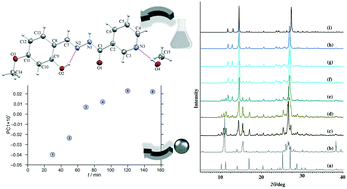
CrystEngComm, 2018,20, 1804-1817
https://doi.org/10.1039/C7CE02136D
Polymorphism of chlorpropamide on liquid-assisted mechanical treatment: choice of liquid and type of mechanical treatment matter
Different types of mechanical treatment (tableting, grinding, milling, etc.) are important technological operations in the pharmaceutical industry.
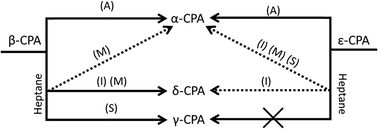
CrystEngComm, 2018,20, 1797-1803
https://doi.org/10.1039/C7CE02221B
The effect of the ball to reactant ratio on mechanochemical reaction times studied by in situ PXRD
The effect of the ball to reactant ratio on reaction times for a cocrystal formation was studied by in situ PXRD.
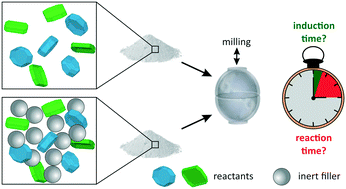
CrystEngComm, 2017,19, 3902-3907
https://doi.org/10.1039/C7CE00502D
Mechanochemically synthesized crystalline luminescent 2D coordination polymers of La3+ and Ce3+, doped with Sm3+, Eu3+, Tb3+, and Dy3+: synthesis, crystal structures and luminescence
A convenient mechanochemical synthesis method has been used to produce luminescent 2D rare-earth coordination polymers.
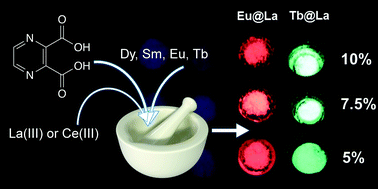
CrystEngComm, 2016,18, 6738-6747
https://doi.org/10.1039/C6CE01166G
Isoniazid cocrystallisation with dicarboxylic acids: vapochemical, mechanochemical and thermal methods
A systematic study on mechanochemical, thermal and vapochemical cocrystallisation demonstrates the effect of compound properties on the outcome of the reaction.
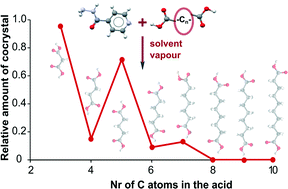
CrystEngComm, 2016,18, 1625-1635
https://doi.org/10.1039/C5CE01774B
Polymorphism control in the mechanochemical and solution-based synthesis of a thermochromic Schiff base
Three crystal forms of a thermochromic Schiff base derived from o-vanillin and 3-aminoacetophenone were obtained by conventional solution-based methods. Two polymorphs out of three were synthesized by mechanochemical syntheses, under solvent-free conditions.
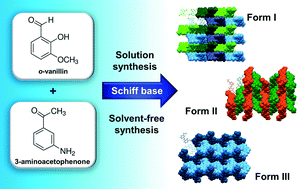
CrystEngComm, 2015,17, 7870-7877
https://doi.org/10.1039/C5CE01445J
Structural and optical characterization of ball-milled copper-doped bismuth vanadium oxide (BiVO4)
Mechano-chemical synthesis of Cu-doped BiVO4 monoclinic nanopowders and investigation of structural, optical and electronic properties.
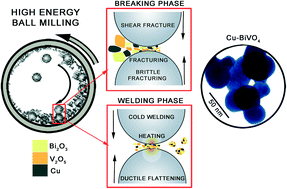
CrystEngComm, 2015,17, 3366-3375
https://doi.org/10.1039/C5CE00173K
Studies on polymorph conversion in a new cyclodextrin inclusion compound
4-Phenylpyridine-N-oxide and βCD form a stoichiometric inclusion complex with two polymorphs occurring at different crystallisation times. The irreversible conversion of one polymorph into the other was monitored in real time for the first time.

CrystEngComm, 2015,17, 937-946
https://doi.org/10.1039/C4CE02041C
Rapid mechanochemical synthesis of two new Cd(II)-based metal–organic frameworks with high removal efficiency of Congo red
Two new three-dimensional porous Cd(II)-based metal–organic frameworks, TMU-8 and TMU-9, with high performance in adsorption of Congo red.
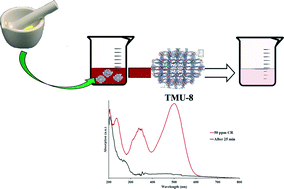
CrystEngComm, 2015,17, 686-692
https://doi.org/10.1039/C4CE01783H
The effect of mechano-stimuli on the amorphous-to-crystalline transition of mechanochromic luminescent materials
Mechano-stimuli, which causes mechanochromic luminescence when being applied on crystalline materials, facilitates the annealing crystallization of amorphous materials.
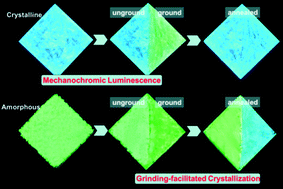
CrystEngComm, 2015,17, 526-531
https://doi.org/10.1039/C4CE01212G
Improvement of the water solubility of tolfenamic acid by new multiple-component crystals produced by mechanochemical methods
Tolfenamic acid (HTA) is a drug characterized by very poor solubility in water. By mechanochemical methods, new solid-state forms of HTA were obtained, showing better thermal stability than pure HTA and an improved dissolution rate.

CrystEngComm, 2014,16, 8252-8262
https://doi.org/10.1039/C4CE00549J
The role of a liquid in “dry” co-grinding: a case study of the effect of water on mechanochemical synthesis in a “L-serine–oxalic acid” system
[L-serH]2[ox]·2H2O form II proved to be an intermediate product in the reaction for obtaining the form I.
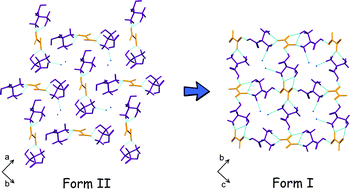
CrystEngComm, 2014,16, 3857-3866
https://doi.org/10.1039/C3CE42321B
Mechanochemical dehydrochlorination and chelation reaction in the solid state: from a molecular salt to a coordination complex
A solid-state reaction from a metal organic salt into a coordination complex is achieved via a dehydrochlorination reaction by grinding.
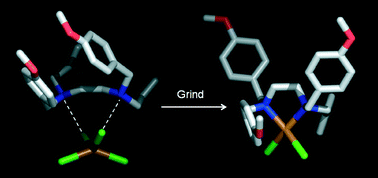
CrystEngComm, 2014,16, 969-973
https://doi.org/10.1039/C3CE41900B
‘Hedvall effect’ in cryogrinding of molecular crystals. A case study of a polymorphic transition in chlorpropamide
A phase transition, induced by low temperature, facilitates another one, induced by mechanical treatment.
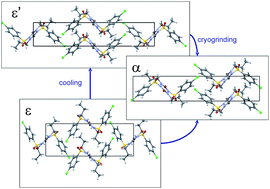
CrystEngComm, 2011,13, 4405-4410
https://doi.org/10.1039/C1CE05189J
A stepwise mechanism and the role of water in the liquid-assisted grinding synthesis of metal–organic materials
Mechanosynthesis of metal–organic materials from ZnO or CuO proceeds via a stepwise mechanism and can be regulated by the mole fraction and the activity of water in the grinding liquid.

CrystEngComm, 2010,12, 2409-2418
https://doi.org/10.1039/C003521A
Mechanochemical preparation of adducts (co-crystals and molecular salts) of 1,4-diazabicyclo-[2.2.2]-octane with aromatic polycarboxylic acids
Solid-state adducts of DABCO with aromatic polycarboxylic acids were prepared in the solid state by grinding and kneading techniques; the extent of proton transfer between acids and base reflects the trend of solution acidity of the three polycarboxylic acids.
![Graphical abstract: Mechanochemical preparation of adducts (co-crystals and molecular salts) of 1,4-diazabicyclo-[2.2.2]-octane with aromatic polycarboxylic acids](/en/Image/Get?imageInfo.ImageType=GA&imageInfo.ImageIdentifier.ManuscriptID=B922915A&imageInfo.ImageIdentifier.Year=2010)
CrystEngComm, 2010,12, 2107-2112
https://doi.org/10.1039/B922915A
Dimorphs of a 1 : 1 cocrystal of ethenzamide and saccharin : solid-state grinding methods result in metastable polymorph
The ability of solid-state grinding methods, such as neat grinding and solvent-drop grinding, to produce the metastable polymorph of a cocrystal is exemplified by dimorphs of a cocrystal between an analgesic drug, ethenzamide, and saccharin.

CrystEngComm, 2009,11, 889-895
https://doi.org/10.1039/B821373A
Cyanooximes as effective and selective co-crystallizing agents
The cyanooxime preferentially binds to the moiety with the most negative electrostatic potential in a heteroditopic (benzimidazole-pyridine) hydrogen-bond acceptor.
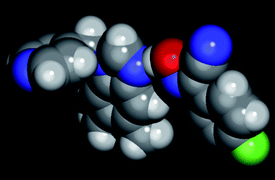
CrystEngComm, 2009,11, 439-443
https://doi.org/10.1039/B811322J
Annealing assisted mechanochemical syntheses of transition-metal coordination compounds and co-crystal formation
Annealing assisted mechanochemical grinding of transition metal complexes activates molecules to form coordination polymers, or encourages diffusion/rearrangement of component molecules to form new crystals by way of recognition or transfer of chirality.
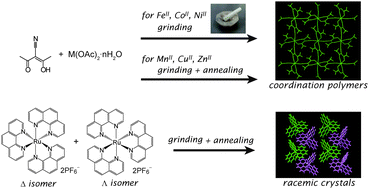
CrystEngComm, 2009,11, 427-432
https://doi.org/10.1039/B819701F
SFM study of the surface of halogen -bonded hybrid co-crystals containing long-chain perfluorocarbons
We report the first in-depth SFM characterization of a prototype halogen-bonded crystalline system to obtain structural and surface compositional information, and investigate nanoscale properties. We expect this study to impact the rational design of perfluorocarbon–hydrocarbon systems, leading to co-crystals with engineered surfaces and predictable properties.
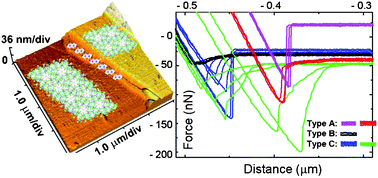
CrystEngComm, 2009,11, 510-515
https://doi.org/10.1039/B815816A
Structural similarities of 2-chlorophenol and 2-methylphenol
Investigation of 2-methylphenol and 2-chlorophenol reveals similarities in structure at both low temperature and high pressure. Co-crystallisation of the two components results in the formation of a 0.45 : 0.55 2-methylphenol : 2-chlorophenol co-crystal at low temperature but at high pressure the mixture is separated resulting in the formation of a new polymorph of 2-chlorophenol.
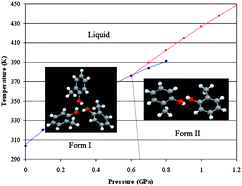
CrystEngComm, 2009,11, 463-469
https://doi.org/10.1039/B813878H
The role of solvent in mechanochemical and sonochemical cocrystal formation: a solubility-based approach for predicting cocrystallisation outcome
Liquid-assisted grinding (LAG) and sonochemical (SonicSlurry) techniques in cocrystallisation were compared by introducing a parameter (η) that allows interpreting and predicting cocrystal formation in a range of solvents and concentrations by considering reactant saturation levels.
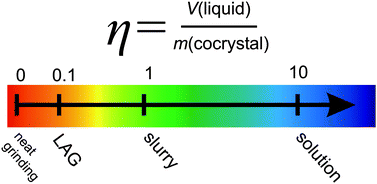
CrystEngComm, 2009,11, 418-426
https://doi.org/10.1039/B815174A
An array-based study of reactivity under solvent -free mechanochemical conditions—insights and trends
Reactions between metal salts and bridging ligands in a ball mill are found to be remarkably general. Some insights and trends are revealed by studying an array of 60 potential reactions between various ligands and metal salts.
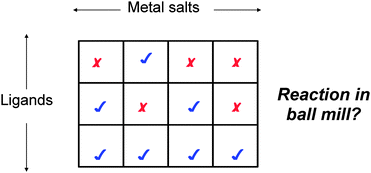
CrystEngComm, 2008,10, 1839-1847
https://doi.org/10.1039/B810857A
About this collection
This Editor’s collection, guest edited by Editorial Board Member Elena Boldyreva highlights a number of articles in the field of Mechanochemistry.
Mechanochemistry is a branch of chemistry which has been known for a long time and yet has undergone rapid development in the last two decades and indeed IUPAC has recently included mechanochemistry in top-5 innovations that will change the world. (https://www.chemistryworld.com/news/iupac-names-10-chemistry-innovations-that-will-change-the-world/3010335.article)
CrystEngComm has published a number of cutting-edge papers on mechanochemistry in the twenty years that the journal has existed. The first paper on mechanochemistry was published in 2004, and since then papers on various aspects of mechanochemistry have appeared regularly, including a themed issue focusing on Mechanochemistry and cocrystals published in 2009. These papers have reported new synthesis, new techniques, as well as the results of original and profound mechanistic studies.